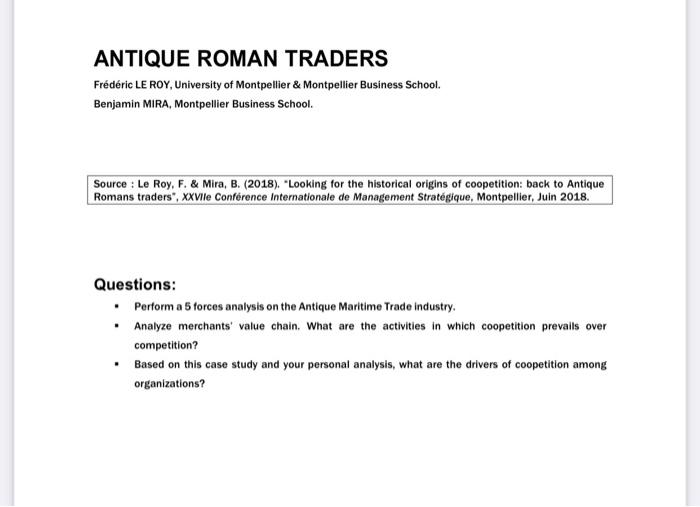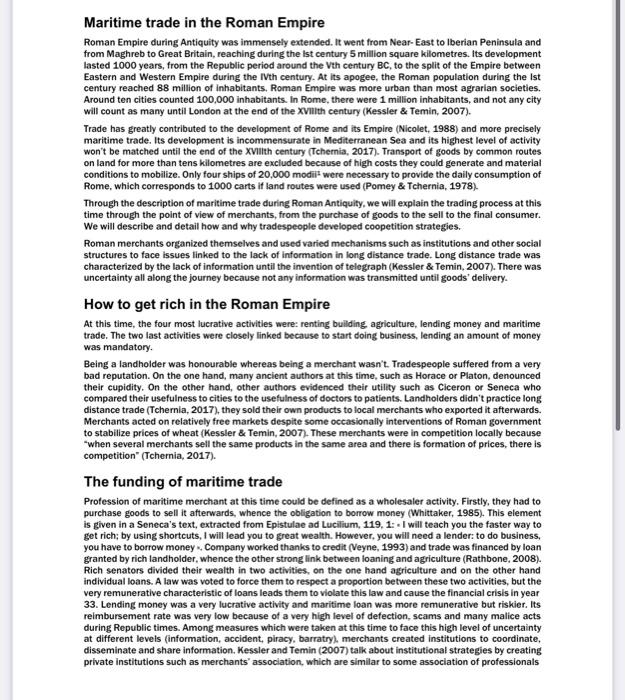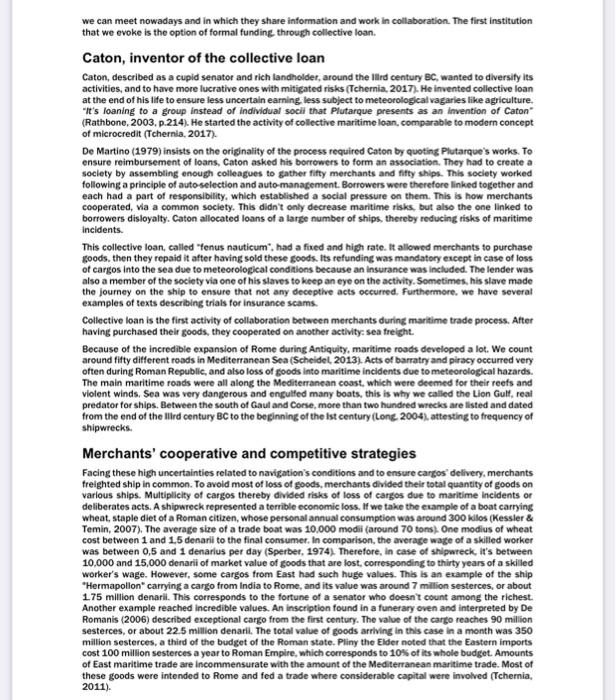ANTIQUE ROMAN TRADERS Frdric LE ROY, University of Montpellier \& Montpellier Business School. Benjamin MIRA, Montpellier Business School. Source : Le Roy, F. \& Mira, B. (2018). "Looking for the historical origins of coopetition: back to Antique Romans traders", XXVIle Confrence Internationale de Management Stratgique, Montpellier, Juin 2018. Questions: - Perform a 5 forces analysis on the Antique Maritime Trade industry. - Analyze merchants' value chain. What are the activities in which coopetition prevails over competition? - Based on this case study and your personal analysis, what are the drivers of coopetition among organizations? The highest the tonnage was and the cheapest the fret was (Tchernia, 2011), which influenced merchants to fill boats for deliveries by associating. Freight transports of goods by the sea were long and expensive. Scheidel (2013) calculated and estimated prices and durations of journeys for every maritime road of Mediterranean Sea. For example, a journey between Ostia (harbour of Rome) and Messina in Sicilia lasted 4 days and cost 6 denarii. A journey between Alexandria and Ostia lasted 18 days and cost 16 denarii. By comparing these data to the average wage of a skilled worker, it gives us clues about the magnitude of the journeys' costs. It was possible to rent space on a boat of another merchant or to freight it entirely (mercium uehendarum). Some merchants were owners of their boat, and other didn't. Plurality of merchants is common. Hesnard and Gianfrotta (1989) had already observed "common freight for a journey* about Italian wine at the end of Republic time. This example of cooperation between competing merchants was discovered due to amphorae found on shipwrecks. They give excellent clues and indications because the names of merchants, wholesalers, potential intermediaries and recipients were written on it. Moreover, we know what they contained because of their shapes (Etienne \& Mayet, 2002). Names written on it give us the number of merchants who coexisted during the same period of time and for the same traffic, thus explaining competition among them (Tchernia, 2011). After the discover and the analysis of PortVendres II shipwreck in Mediterranean Sea, inscriptions on amphorae indicate that nine different merchants associated to rent this ship (Colls, Dali, \& al., 1977). With many owners for an only freight, risks are divided; the effect is the same as the one about the association imposed by Caton to his borrowers. It is an act of safety which needs many actors and transactions. We also have other examples of cooperation between Roman merchants. Kessler and Temin (2007) quote The Guild System of Ostia that built institutional barriers against environmental hazards and preserved members from merchants' opportunistic acts. These guilds were formal organizations of men linked by a common activity. Authors approach the subject of coopetition without naming it: "All guilds allowed their members to compete freely with each other" (Kessler \& Temin, 2007, p. 326). As the association created to get collective loan, these guilds were auto-managed in order prevent members' malicious acts. Members could reject a merchant's ask for membership, or also punish members who behaved badly. Merchants relied on the incentives to preserve reputations in order to promote honesty and fair dealing. Somebody who is afraid of being punished would be less likely to cheat. We have examples of guilds like The Piazzale delle Corporazioni in Ostia, which was the first physical institution where information among merchants of wheat was shared. Wine merchants also met at Forum Vinarium. It clearly appears that merchants met deliberately to coordinate and to share information (Kessler \& Temin, 2007). These institutions played an important role in reducing costs linked to asymmetry and incomplete information problems. Merchants used economical and social institutions to reduce costs of environment's uncertainties. These institutions increased amount of available information among merchants and helped the development of maritime trade. we can meet nowadays and in which they share information and work in collaboration. The first institution that we evoke is the option of formal funding through collective loan. Caton, inventor of the collective loan Caton, described as a cupid senator and rich landholder, around the Iillid century BC, wanted to diversify its activities, and to have more lucrative ones with mitigated risks (Tchernia, 2017). He invented collective loan at the end of his life to ensure less uncertain earning, less subject to meteorological vagarles like agriculture. "It's loaning to a group instead of individual socili that Plutarque presents as an imvention of Caton" (Rathbone, 2003, p.214). He started the activity of collective maritime loan, comparable to modern concept of microcredit (Tchernia, 2017). De Martino (1979) insists on the orignality of the process required Caton by quoting Plutarque's works. To ensure reimbursement of loans, Caton asked his borrowers to form an association. They had to create a society by assembling enough colleagues to gather fifty merchants and fifty ships. This society worked following a principle of autoselection and auto-management. Borrowers were therefore linked together and each had a part of responsibility, which established a social pressure on them. This is how merchants cooperated, va a common society. This didn't only decrease maritime risks, but also the one linked to borrowers disloyalty. Caton allocated loans of a large number of ships, thereby reducing risks of maritime incidents. This collective loan, called "fenus nauticum", had a fixed and hiph rate. it allowed merchants to purchase goods, then they repaid it after having sold these goods. Its refunding was mandatory except in case of loss of cargos into the sea due to meteorological conditions because an insurance was included. The lender was also a member of the society via one of his slaves to keep an eye on the activity. Sometimes, his slave made the journey on the ship to ensure that not any deceptive acts occurred. Furthermore, we have several examples of texts describing trials for insurance scams. Collective loan is the first activity of collaboration between merchants during maritime trade process. After having purchased their goods, they cooperated on another activity: sea freight. Because of the incredible expansion of Rome during Antiquity, maritime roads developed a lot. We count around fifty different roads in Mediterranean Sea (ScheideL, 2013). Acts of barratry and piracy oceurred very often during Roman Republic, and also loss of goods into maritime incidents due to meteorologjcal hazards. The main maritime roads were all along the Mediterranean coast, which were deemed for their reefs and vielent winds. Sea was very dangerous and engulfed many boats, this is why we called the Lion Gulf, real predator for ships. Between the south of Gaul and Corse, more than two hundred wrecks are listed and dated from the end of the llird century BC to the beginning of the ist century (Lone 2004), attesting to frequency of shipwrecks. Merchants' cooperative and competitive strategies Facing these high uncertainties related to navigation's conditions and to ensure cargos' delivery, merchants freighted ship in common. To avoid most of loss of goods, merchants divided their total quantity of goods on various ships. Multiplicity of cargos thereby divided risks of loss of cargos due to maritime ineidents or deliberates acts. A shipwreck represented a terrible economic loss. If we take the example of a boat carrying wheat, staple diet of a Roman citizen, whose personal annual consumption was around 300 kllos (Kessler \& Temin, 2007). The average size of a trade boat was 10.000 modii (around 70 tons). One modlus of wheat cost between 1 and 1.5 denaril to the final consumer. in comparison, the averase wage of a skilled worker was between 0,5 and 1 denarius per day (Sperber, 1974). Therefore, in case of shipwreck, it's between 10,000 and 15,000 denarii of market value of goods that are lost, corresponding to thirty years of a skilled worker's wage. However, some cargos from East had such huge values. This is an example of the ship "Hermapollon" carrying a cargo from India to Rome, and its value was around 7 million sesterces, or about 175 million denaril. This corresponds to the fortune of a senator who doesn't count among the richest. Another example reached incredible values. An inscription found in a funerary oven and interpreted by De Romanis (2006) described exceptional cargo from the first century. The value of the cargo reaches 90 million sesterces, or about 22.5 million denaril. The total value of goods arriving in this case in a month was 350 million sesterces, a third of the budget of the Roman state. Pliny the Elder noted that the Eastern imports cest 100 million sesterces a year to Roman Empire, which corresponds to 10% of its whole budget. Amounts of East maritime trade are incommensurate with the amount of the Mediterranean maritime trade. Most of these goods were intended to Rome and fed a trade where considerable capital were involved (Tchernia, 2011). Maritime trade in the Roman Empire Roman Empire during Antiquity was immensely extended. It went from Near- East to Iberian Peninsula and from Maghreb to Great Britain, reaching during the ist century 5 million square kilometres. Its development lasted 1000 years, from the Republic period around the Vth century BC, to the split of the Empire between Eastern and Western Empire during the IVth century. At its apogee, the Roman population during the Ist century reached 88 million of inhabitants. Roman Empire was more urban than most agrarian societies. Around ten cities counted 100,000 inhabitants. In Rome, there were 1 million inhabitants, and not any city will count as many until London at the end of the XVilith century (Kessler \& Temin, 2007). Trade has greatly contributed to the development of Rome and its Empire (Nicolet, 1988) and more precisely maritime trade. Its development is incommensurate in Mediterranean Sea and its highest level of activity won't be matched until the end of the XVilith century (Tchernia, 2017). Transport of goods by common routes on land for more than tens kilometres are excluded because of high costs they could generate and material conditions to mobilize. Only four ships of 20,000 modiil were necessary to provide the daily consumption of Rome, which corresponds to 1000 carts if land routes were used (Pomey \& Tchernia, 1978). Through the description of maritime trade during Roman Antiquity, we will explain the trading process at this time through the point of view of merchants, from the purchase of goods to the sell to the final consumer. We will describe and detail how and why tradespeople developed coopetition strategies. Roman merchants organized themselves and used varied mechanisms such as institutions and other social structures to face issues linked to the lack of information in long distance trade. Long distance trade was characterized by the lack of information until the invention of telegraph (Kessler \& Temin, 2007). There was uncertainty all along the journey because not any information was transmitted until goods' delivery. How to get rich in the Roman Empire At this time, the four most lucrative activities were: renting buliding, agriculture, lending money and maritime trade. The two last activities were closely linked because to start doing business, lending an amount of money was mandatory. Being a landholder was honourable whereas being a merchant wasn't. Tradespeople suffered from a very bad reputation. On the one hand, many ancient authors at this time, such as Horace or Platon, denounced their cupidity. On the other hand, other authors evidenced their utility such as Ciceron or Seneca who compared their usefulness to cities to the usefulness of doctors to patients. Landholders didn't practice long distance trade (Tchernia, 2017), they sold their own products to local merchants who exported it afterwards. Merchants acted on relatively free markets despite some occasionally interventions of Roman government to stabilize prices of wheat (Kessler \&. Temin, 2007). These merchants were in competition locally because "when several merchants sell the same products in the same area and there is formation of prices, there is competition" (Tchernia, 2017). The funding of maritime trade Profession of maritime merchant at this time could be defined as a wholesaler activity. Firstly, they had to purchase goods to sell it afterwards, whence the obligation to borrow money (Whittaker, 1985). This element is given in a Seneca's text, extracted from Epistulae ad Lucilium, 119, 1: - I will teach you the faster way to get rich; by using shortcuts, I will lead you to great wealth. However, you will need a lender: to do business, you have to borrow money *, Company worked thanks to credit (Veyne, 1993) and trade was financed by loan granted by rich landholder, whence the other strong link between loaning and agriculture (Rathbone, 2008). Rich senators divided their wealth in two activities, on the one hand agriculture and on the other hand individual loans. A law was voted to force them to respect a proportion between these two activities, but the very remunerative characteristic of loans leads them to violate this law and cause the financial crisis in year 33. Lending money was a very lucrative activity and maritime loan was more remunerative but riskier. Its reimbursement rate was very low because of a very high level of defection, scams and many malice acts during Republic times. Among measures which were taken at this time to face this high level of uncertainty at different leveis (information, accident, piracy, barratry), merchants created institutions to coordinate, disseminate and share information. Kessler and Temin (2007) talk about institutional strategles by creating private institutions such as merchants' association, which are similar to some association of professionals










